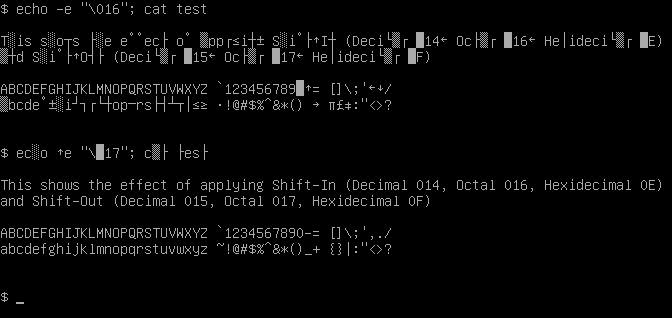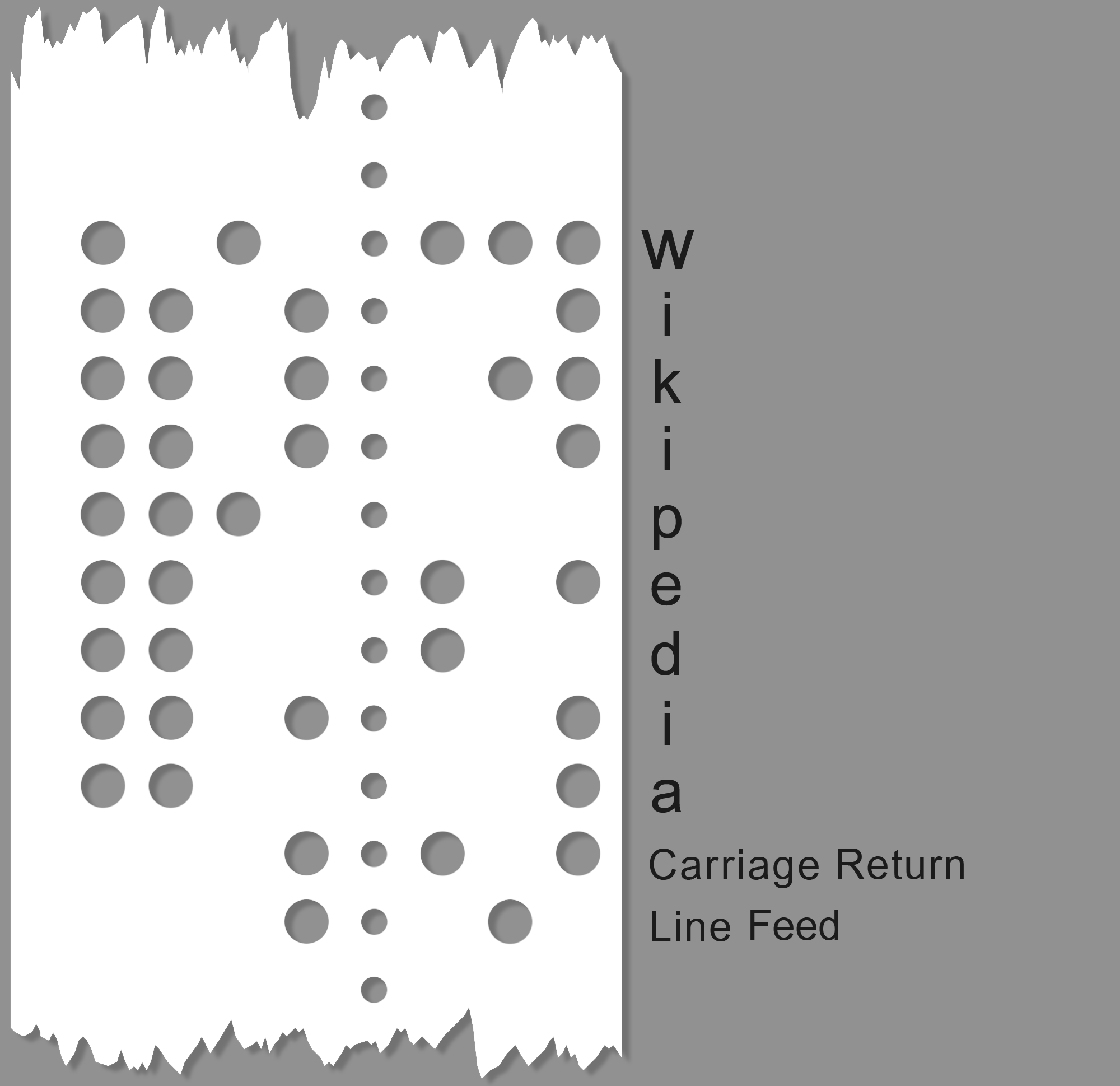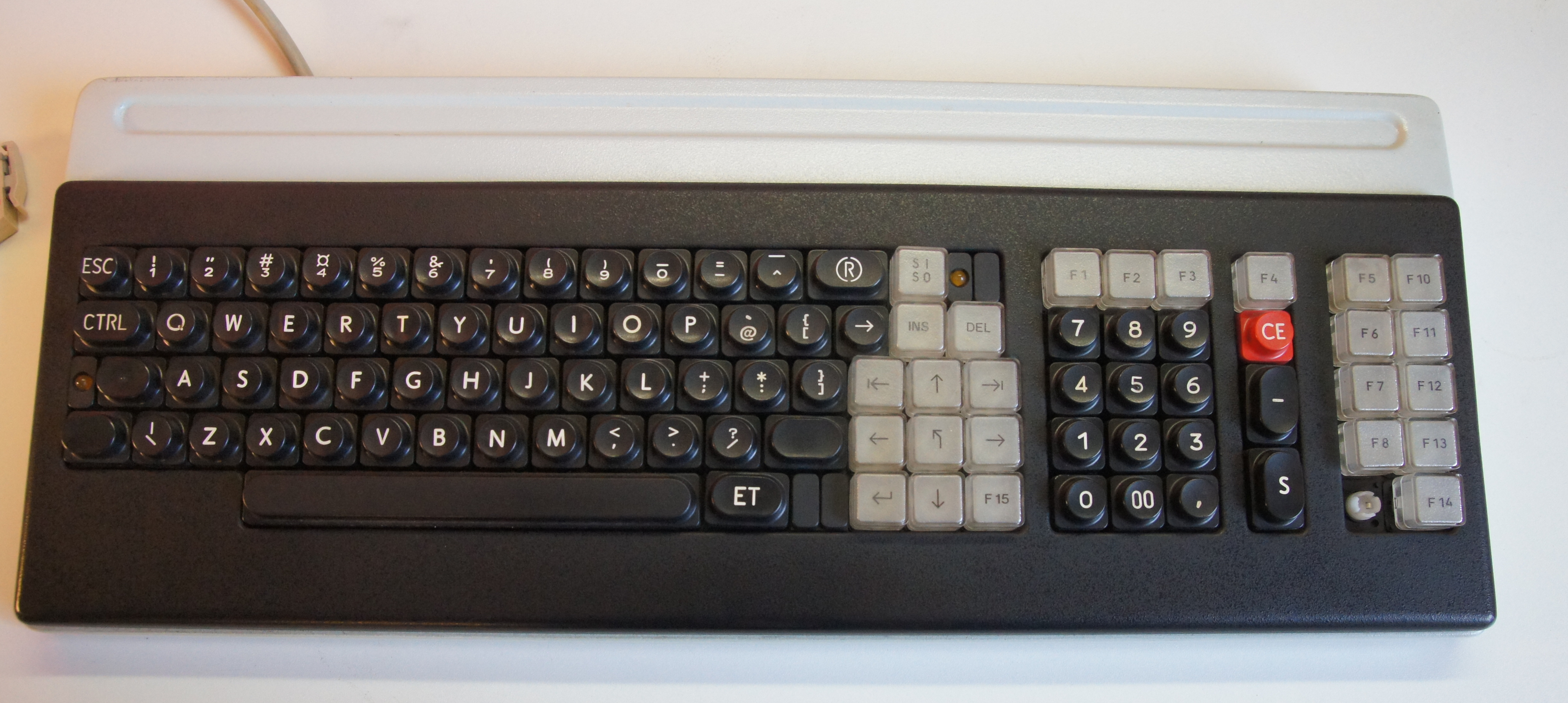|
KOI7
KOI-7 (КОИ-7) is a 7-bit character encoding, designed to cover Russian, which uses the Cyrillic alphabet. In Russian, KOI-7 stands for ''Kod Obmena Informatsiey, 7 bit'' (Код Обмена Информацией, 7 бит) which means "Code for Information Exchange, 7 bit". It was first standardized in GOST 13052-67 (with the 2nd revision GOST 13052-74 / ST SEV 356-76) and GOST 27463-87 / ST SEV 356-86. Shift Out (SO) and Shift In (SI) control characters are used in KOI-7, where SO starts printing Russian letters (KOI-7 N1), and SI starts printing Latin letters again (KOI-7 N0), or for lowercase and uppercase switching. This version is also known as KOI7-switched aka csKOI7switched. On ISO 2022 compatible computer terminals KOI7-switched can be activated by the escape sequence ESC ( @ ESC ) N LS0. KOI-7 was used on machines like the SM EVM (СМ ЭВМ) and DVK (ДВК); KOI-7 N2 was utilized in the machine-language of the (Elektronika D3-28) as four-digit hexade ... [...More Info...] [...Related Items...] OR: [Wikipedia] [Google] [Baidu] |
Shift Out
Shift Out (SO) and Shift In (SI) are ASCII control characters 14 and 15, respectively (0x0E and 0x0F). These are sometimes also called "Control-N" and "Control-O". The original purpose of these characters was to provide a way to shift a coloured ribbon, split longitudinally usually with red and black, up and down to the other colour in an electro-mechanical typewriter or teleprinter, such as the Teletype Model 38, to automate the same function of manual typewriters. Black was the conventional ambient default colour and so was shifted "in" or "out" with the other colour on the ribbon. Later advancements in technology instigated use of this function for switching to a different font or character set and back. This was used, for instance, in the Russian character set known as KOI7-switched, where SO starts printing Russian letters, and SI starts printing Latin letters again. Similarly, they are used for switching between Katakana and Roman letters in the 7-bit version of the Jap ... [...More Info...] [...Related Items...] OR: [Wikipedia] [Google] [Baidu] |
Character Encoding
Character encoding is the process of assigning numbers to graphical character (computing), characters, especially the written characters of human language, allowing them to be stored, transmitted, and transformed using computers. The numerical values that make up a character encoding are known as code points and collectively comprise a code space or a code page. Early character encodings that originated with optical or electrical telegraphy and in early computers could only represent a subset of the characters used in written languages, sometimes restricted to Letter case, upper case letters, Numeral system, numerals and some punctuation only. Over time, character encodings capable of representing more characters were created, such as ASCII, the ISO/IEC 8859 encodings, various computer vendor encodings, and Unicode encodings such as UTF-8 and UTF-16. The Popularity of text encodings, most popular character encoding on the World Wide Web is UTF-8, which is used in 98.2% of surve ... [...More Info...] [...Related Items...] OR: [Wikipedia] [Google] [Baidu] |
US-ASCII
ASCII ( ), an acronym for American Standard Code for Information Interchange, is a character encoding standard for representing a particular set of 95 (English language focused) printable character, printable and 33 control character, control characters a total of 128 code points. The set of available punctuation had significant impact on the syntax of computer languages and text markup. ASCII hugely influenced the design of character sets used by modern computers; for example, the first 128 code points of Unicode are the same as ASCII. ASCII encodes each code-point as a value from 0 to 127 storable as a seven-bit integer. Ninety-five code-points are printable, including digits ''0'' to ''9'', lowercase letters ''a'' to ''z'', uppercase letters ''A'' to ''Z'', and commonly used punctuation symbols. For example, the letter is represented as 105 (decimal). Also, ASCII specifies 33 non-printing control codes which originated with ; most of which are now obsolete. The control cha ... [...More Info...] [...Related Items...] OR: [Wikipedia] [Google] [Baidu] |
SM EVM
SM EVM (СМ ЭВМ, abbreviation of Система Малых ЭВМ—literally System of Mini Computers) are several types of Soviet and Comecon minicomputers produced from 1975 through the 1980s. Most types of SM EVM are clones of DEC PDP-11 and VAX. SM-1 and SM-2 are clones of Hewlett-Packard minicomputers. The common operating systems for the PDP-11 clones are translated versions of RSX-11 (ОС РВ) for the higher spec models and RT-11 (РАФОС, ФОДОС) for lower spec models. Also available for the high-end PDP-11 clones is MOS, a clone of UNIX Unix (, ; trademarked as UNIX) is a family of multitasking, multi-user computer operating systems that derive from the original AT&T Unix, whose development started in 1969 at the Bell Labs research center by Ken Thompson, Dennis Ritchie, a .... See also * SM-4 * SM-1420 * SM-1600 * SM-1710 * SM-1720 References Computer-related introductions in 1975 Minicomputers Soviet computer systems PDP-11 Comput ... [...More Info...] [...Related Items...] OR: [Wikipedia] [Google] [Baidu] |
RSX-11
RSX-11 is a discontinued family of multi-user real-time operating systems for PDP-11 computers created by Digital Equipment Corporation. In widespread use through the late 1970s and early 1980s, RSX-11 was influential in the development of later operating systems such as OpenVMS, VMS and Windows NT. As the original ''Real-Time System Executive'' name suggests, RSX was designed (and commonly used) for real time use, with process control a major use. It was also popular for program development and general computing. History Name and origins RSX-11 began as a port to the PDP-11 architecture of the earlier RSX-15 operating system for the PDP-15 minicomputer, first released in 1971. The main architect for RSX-15 (later renamed XVM/RSX) was Dennis “Dan” Brevik. Commenting on the ''RSX'' acronym, Brevik says: RSX-11D and IAS The porting effort first produced small paper tape based real-time executives (RSX-11A, RSX-11C) which later gained limited support for disks (RSX-11B). RSX ... [...More Info...] [...Related Items...] OR: [Wikipedia] [Google] [Baidu] |
RT-11
RT-11 (Real-time 11) is a discontinued small, low-end, single-user real-time operating system for the full line of Digital Equipment Corporation PDP-11 16-bit computers. RT-11 was first implemented in 1970. It was widely used for real-time computing systems, process control, and data acquisition across all PDP-11s. It was also used for low-cost general-use computing. Features Source code RT-11 was written in assembly language. Heavy use of the conditional assembly and macro programming features of the MACRO-11 assembler allowed a significant degree of configurability and allowed programmers to specify high-level instructions otherwise unprovided for in machine code. RT-11 distributions included the source code of the operating system and its device drivers with all the comments removed and a program named "SYSGEN" which would build the operating system and drivers according to a user-specified configuration. Developer's documentation included a kernel listing that included ... [...More Info...] [...Related Items...] OR: [Wikipedia] [Google] [Baidu] |
ISO 646
ISO/IEC 646 ''Information technology — ISO 7-bit coded character set for information interchange'', is an International Organization for Standardization, ISO/International Electrotechnical Commission, IEC standard in the field of character encoding. It is equivalent to the Ecma International, ECMA standard ECMA-6 and developed in cooperation with ASCII at least since 1964. The first version of ECMA-6 had been published in 1965, based on work the ECMA's Technical Committee TC1 had carried out since December 1960. The first edition of ISO/IEC 646 was published in 1973, and the most recent, third, edition in 1991. ISO/IEC 646 specifies a 7-bit character code from which several national standards are derived. It allocates a set of 82 unique graphic characters to 7-bit code points, known as the ''invariant'' (INV) or ''basic character set'', including letters of the ISO basic Latin alphabet, Numerical digit, digits, and some common English language, English pun ... [...More Info...] [...Related Items...] OR: [Wikipedia] [Google] [Baidu] |
KOI Character Encodings
KOI (''КОИ'') is a family of several code pages for the Cyrillic script. The name stands for ''Kod obmena informatsiey'' () which means "Code for Information Interchange". A particular feature of the KOI code pages is that the text remains human-readable when the leftmost bit is stripped, should it inadvertently pass through equipment or software that can only deal with 7 bit wide characters. This is due to characters being placed in a special order (128 codepoints apart from the Latin letter they sound most similar to), which, however, does not correspond to the alphabetic order in any language that is written in Cyrillic and necessitates the use of lookup tables to perform Sorting algorithm, sorting. These encodings are derived from ASCII on the base of some correspondence between Latin and Cyrillic (nearly phonetical), which was already used in Russian Morse code, Russian dialect of Morse code and in MTK-2 telegraph code. The first 26 characters from А (0xE1) in KOI8-R are � ... [...More Info...] [...Related Items...] OR: [Wikipedia] [Google] [Baidu] |
ISO 2022
ISO/IEC 2022 ''Information technology—Character code structure and extension techniques'', is an ISO/IEC standard in the field of character encoding. It is equivalent to the ECMA standard ECMA-35, the ANSI standard ANSI X3.41 and the Japanese Industrial Standard JIS X 0202. Originating in 1971, it was most recently revised in 1994. ISO 2022 specifies a general structure which character encodings can conform to, dedicating particular ranges of bytes ( 0x00–1F and 0x7F–9F) to be used for non-printing control codes for formatting and in-band instructions (such as line breaks or formatting instructions for text terminals), rather than graphical characters. It also specifies a syntax for escape sequences, multiple-byte sequences beginning with the control code, which can likewise be used for in-band instructions. Specific sets of control codes and escape sequences designed to be used with ISO 2022 include ISO/IEC 6429, portions of which are implemented by ANSI.SYS and te ... [...More Info...] [...Related Items...] OR: [Wikipedia] [Google] [Baidu] |
Dollar Sign
The dollar sign, also known as the peso sign, is a currency symbol consisting of a Letter case, capital crossed with one or two vertical strokes ( or depending on typeface), used to indicate the unit of various currency, currencies around the world, including most currencies denominated "dollar" or "peso". The explicitly double-barred sign is called cifrão in the Portuguese language. The sign is also used in several compound currency symbols, such as the Brazilian real (R$) and the United States dollar (US$): in local use, the nationality prefix is usually omitted. In countries that have other currency symbols, the US dollar is often assumed and the "US" prefix omitted. The one- and two-stroke versions are often considered mere stylistic (typeface) variants, although in some places and epochs one of them may have been specifically assigned, by law or custom, to a specific currency. The Unicode computer encoding standard defines a single code for both. In most English l ... [...More Info...] [...Related Items...] OR: [Wikipedia] [Google] [Baidu] |
Universal Currency Sign
The currency sign is a character used to denote an unspecified currency. It can be described as a circle the size of a lowercase character with four short radiating arms at 45° (NE), 135° (SE), 225° (SW) and 315° (NW). It is raised slightly above the baseline. The character is sometimes called scarab. History The symbol was first encoded for computers in 1972, as a placeholder for national currency symbols such as the dollar sign, in national variants (ISO 646) of ASCII and the International Reference Variant. It was proposed by Italy as an alternative (to the dollar sign) at 0x24. In reality, most national standards retained the dollar sign as too important. ASCII and ISO 646 were specified as 7-bit encoding, which allowed for 96 printable characters and 32 control codes. The character is used in the GSM default 7-bit encoding as specified in 3GPP TS 23.038 / GSM 03.38 at 0x24. The introduction of 8-bit encoding and the ISO/IEC 8859 code pages meant that all major n ... [...More Info...] [...Related Items...] OR: [Wikipedia] [Google] [Baidu] |





